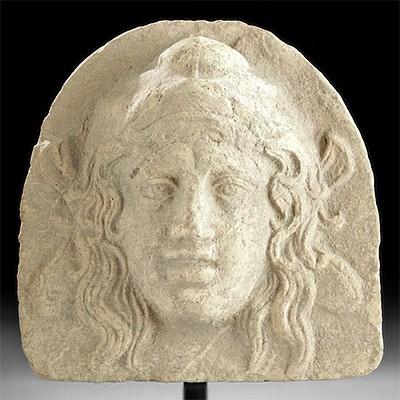Colima Redware Vessel - Resting Dog
Lot 143d
About Seller
Artemis Fine Arts
686 S Taylor Ave, Ste 106
Louisville, CO 80027
United States
Selling antiquities, ancient and ethnographic art online since 1993, Artemis Gallery specializes in Classical Antiquities (Egyptian, Greek, Roman, Near Eastern), Asian, Pre-Columbian, African / Tribal / Oceanographic art. Our extensive inventory includes pottery, stone, metal, wood, glass and textil...Read more
Estimate:
$1,100 - $1,600
Absentee vs Live bid
Two ways to bid:
- Leave a max absentee bid and the platform will bid on your behalf up to your maximum bid during the live auction.
- Bid live during the auction and your bids will be submitted real-time to the auctioneer.
Bid Increments
| Price | Bid Increment |
|---|---|
| $0 | $25 |
| $300 | $50 |
| $1,000 | $100 |
| $2,000 | $250 |
| $5,000 | $500 |
| $10,000 | $1,000 |
| $20,000 | $2,500 |
| $50,000 | $5,000 |
| $100,000 | $10,000 |
| $200,000 | $20,000 |
About Auction
By Artemis Fine Arts
Feb 27, 2020
Set Reminder
2020-02-27 10:00:00
2020-02-27 10:00:00
America/New_York
Bidsquare
Bidsquare : VARIETY SALE | Antiquities & Ethnographic Art
https://www.bidsquare.com/auctions/artemis-gallery/variety-sale-antiquities-ethnographic-art-4920
Around the world & back in time - be amazed at the treasures you will find. Antiquities from Egypt, Greece, Italy and the Near East, Asian, Pre-Columbian, African / Tribal / Oceanic, Native American, Spanish Colonial, Russian Icons, Fine Art, much more! Artemis Fine Arts info@artemisfinearts.com
Around the world & back in time - be amazed at the treasures you will find. Antiquities from Egypt, Greece, Italy and the Near East, Asian, Pre-Columbian, African / Tribal / Oceanic, Native American, Spanish Colonial, Russian Icons, Fine Art, much more! Artemis Fine Arts info@artemisfinearts.com
- Lot Description
Pre-Columbian, West Mexico, Colima, Protoclassic period, ca. 100 BCE to 250 CE. A hand-built and highly burnished redware pottery vessel with a flat base, a horseshoe-shaped body, and a raised head opposite a broad spout. The vessel takes the form of a charming canine who rests its head atop its posterior and has a pair of nubbin-shaped legs on either end of the body. The face of the sleepy pup exhibits impressed hemispherical eyes with heavy lids, a conical snout, a bulging brow, and a pair of gently cupped ears. Size: 8.5" L x 7.125" W x 5.375" H (21.6 cm x 18.1 cm x 13.7 cm)
Scholars know of at least two types of Colima dogs, one to be fattened up and ritually sacrificed or eaten and one to serve as a watchdog and healer of the ill. This plump hairless canine, known as a Chichi or Escuintla, is thought to be related to the Chihuahua or the Mexican Hairless also known as the Xoloitzcuintle. The Xoloitzcuintle was named for the deity Xolotl, the God of the Underworld, and was believed to guide the deceased as they journeyed to the afterlife. Colima vessels such as this one were buried in shaft tombs to protect the deceased and provide sustenance for eternity.
For a stylistically similar example of a curled dog vessel, please see: Kan, Michael, Clement Meighan, and H.B. Nicholson. "Sculpture of Ancient West Mexico: Nayarit, Jalisco, Colima | A Catalogue of the Proctor Stafford Collection at the Los Angeles County Museum of Art." Los Angeles County Museum of Art, 1989, p. 152, fig. 152.; for online photographs, please see the Los Angeles County Museum of Art, accession number M.86.296.156.
Provenance: ex-private Chino Valley, Arizona, USA collection; ex-private Gibralt collection, New York, USA, acquired before 1990
All items legal to buy/sell under U.S. Statute covering cultural patrimony Code 2600, CHAPTER 14, and are guaranteed to be as described or your money back.
A Certificate of Authenticity will accompany all winning bids.
We ship worldwide and handle all shipping in-house for your convenience.
#153539Spout reattached to midsection of body, with resurfacing and overpainting along break lines. Minor nicks and abrasions to spout, base, head, and body, with fading and light chipping to areas of original pigmentation with scattered areas of fire-darkening, and light encrustations. Light earthen deposits, nice manganese deposits, and great remains of original pigment throughout.Condition
- Shipping Info
-
All shipping is handled in-house for your convenience. Your invoice from Artemis Gallery will include shipping calculation instructions. If in doubt, please inquire BEFORE bidding for estimated shipping costs for individual items.
-
- Buyer's Premium



 EUR
EUR CAD
CAD AUD
AUD GBP
GBP MXN
MXN HKD
HKD CNY
CNY MYR
MYR SEK
SEK SGD
SGD CHF
CHF THB
THB















